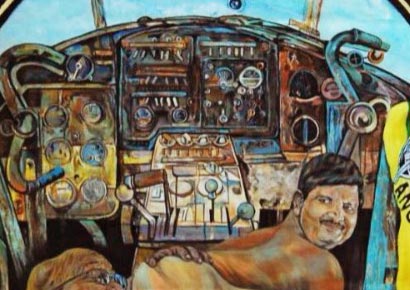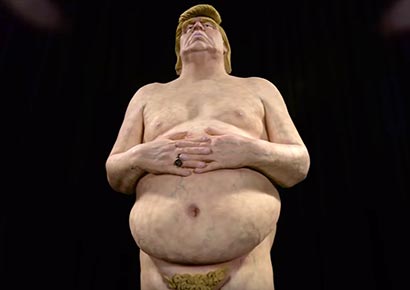The conservatism of sexually explicit political critique
 Earlier this year, Ayanda Mabulu found himself once again at the centre of a controversy sparked by another sexually explicit painting of Jacob Zuma.
Earlier this year, Ayanda Mabulu found himself once again at the centre of a controversy sparked by another sexually explicit painting of Jacob Zuma.
While several of the works displayed at Constitution Hill depicted exposed genitals or overt sex acts, it was a painting of Zuma rimming a naked Atul Gupta in the cockpit of an aeroplane about to crash into another aeroplane that most inspired passionate—both furious and celebratory—responses.
Not long after, Kenny Kunene, in what I imagine was an attempt to ride Mabulu’s coat-tails into the public eye, purchased (and told everyone that he had purchased) a painting by Iven Amali that depicted a naked Mmusi Maimane pulling a rickshaw with a nude James Selfe and a half-dressed Helen Zille as passengers.
These are not South African phenomena alone: most recently the artist collective INDECLINE installed in five American cities statues of a naked Donald Trump, sporting a pot belly, saggy ass, and a small penis, with no testicles, and covered in varicose veins.
These were not the first, nor will they be the last, pieces of artwork to use aesthetics of sexual licentiousness to critique political licentiousness. Sex is routinized in the language we use to express disapproval. One might have said that Zuma and Gupta were in bed together, or that one was kissing the other’s ass, before Mabulu illustrated what that might look like in its most obtusely literal reading.
Understood as an extension of an already-pervasive vocabulary of critique, then, the work of Mabulu, Amali, and INDECLINE lose any sheen of originality. Rather than having pushed any boundaries, these artists have stayed squarely within those already drawn.
But the remarkable lack of originality is among the tame critiques that have been waged at art like this. The public discussion I have read or heard thus far in the South African media has consisted of a narrow set of arguments. On the one hand, disparagers of this art focus on its being disrespectful to the politicians or just generally uncouth. On the other hand, defenders of the art evoked freedom of speech or an appreciation of the artists’ laying bare of the naked truth (facile puns as easy as facile political critique).
Sex and nudity have traction as signifiers of corruption because the idea that sexual licentiousness is a moral deficiency already has traction. A deep sexual conservatism lies at the heart of these artworks that makes it possible for them to masquerade as progressive critique. It is the same sexual conservatism that is the basis of much of the shame and discrimination that people living with HIV experience and that often prevents them from accessing care; sex is dirty so a disease transmitted by sex is a sign of moral failure.
It is the same sexual conservatism—most noticeable in the Mabulu piece—that fuels a lot of homophobia; in a striking parallel, American and Ugandan anti-gay activists used similar scatological imagery to demonize gay sex and advocate for the 2014 Uganda Anti-Homosexuality Act. It is the same sexual conservatism—most noticeable in the INDECLINE piece—that makes immoral synonymous with ugly and that tells us that our power is derived from the size (or presence at all) of our genitals; but is Donald Trump not vile because of his policies and actions rather than the figure and varicose veins a man of his age might quite understandably have (the size of his penis notwithstanding)?

The Emperor Has No Balls – INDECLINE
And let us not forget that colonisers also used exaggerated depictions of racialised sexuality—the hypervirile black man, for instance—to claim moral superiority, to legitimate fear, and ultimately to justify racism. While much of the power of art is derived from the visceral reactions it produces, those emotional responses are not innocent of politics. When we understand how much greater the stakes are in combatting sexual conservatism, we cannot afford to further ingrain the link between sex and immorality.
Political critique should be celebrated, as should the nudity of a diverse range of bodies, as should all kinds of sex, and especially those that don’t conform to the most vanilla heterosexual sex. But it is important that those who create and consume political critique understand that the vocabularies they use to express dissent have origins and consequences that are not ethically neutral. Without prescribing a social role for public and political art, we should expect it at the very least to come up with new aesthetics of critique that at once provide incisive political insight and give us more capacious vocabularies for dissent.
Unfortunately, this art has fallen far short of that.
The type of people that SA has and attracts. Total scum.